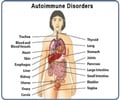A team of US and Swedish researchers have identified a genetic region associated with increased risk of rheumatoid arthritis.
A team of US and Swedish researchers have identified a genetic region associated with increased risk of rheumatoid arthritis (RA), a chronic and debilitating inflammatory disease of the joints.
The U.S. wing of the study involved a long-time partnership between intramural researchers of the National Institute of Arthritis and Musculoskeletal and Skin Diseases (NIAMS) and other organizations.Using the relatively new genome-wide association approach, which makes it possible to analyse between 300,000 and 500,000 single nucleotide polymorphisms, researchers in both countries searched for genetic differences in blood samples from people with RA compared to controls.
The U.S. group compared 908 samples from patients provided by the North American Rheumatoid Arthritis Consortium (NARAC), with those from 1,282 people without RA (controls). The Swedish group compared 676 samples from the Swedish Epidemiological Investigation of Rheumatoid Arthritis (EIRA) with 673 controls.
Both groups' searches led them to a region of chromosome 9 containing two genes relevant to chronic inflammation: TRAF1 (encoding tumor necrosis factor receptor-associated factor 1) and C5 (encoding complement component 5).
"The whole-genome screening method lets us identify genes that contribute to disease-susceptibility without imposing our preconceived notions of the disease. We expected to come up with something new," says Elaine F. Remmers, Ph.D., of the Genetics and Genomics Branch of the NIAMS Intramural Research Program and an author of the study.
"We were thrilled to find out that TRAF1-C5 showed association not only in the samples that we did with NARAC but also independently in the Swedish group. By combining our information, we were able to make a much stronger case [for a TRAF1-C5 association]. The combined evidence was pretty impressive,” she adds.
Advertisement
Researchers hope that by learning more about the genes and their role in the disease, they may find clues to influencing treatment of the disease.
Advertisement
The study is published in the New England Journal of Medicine.
Source-ANI
SRM/S











